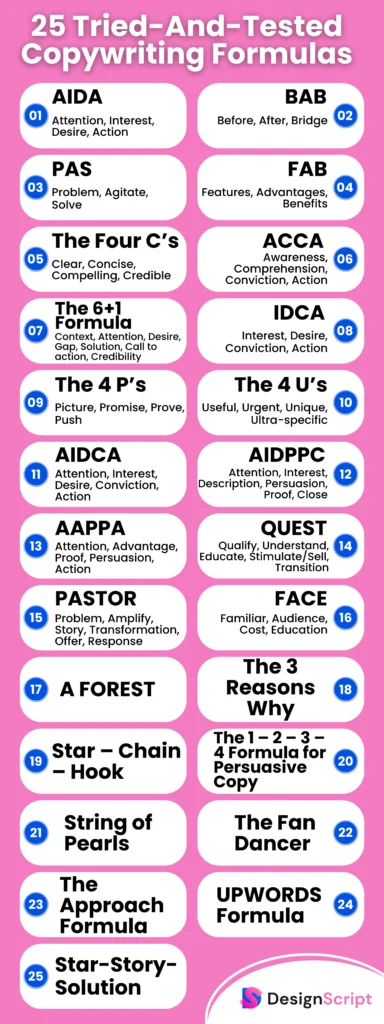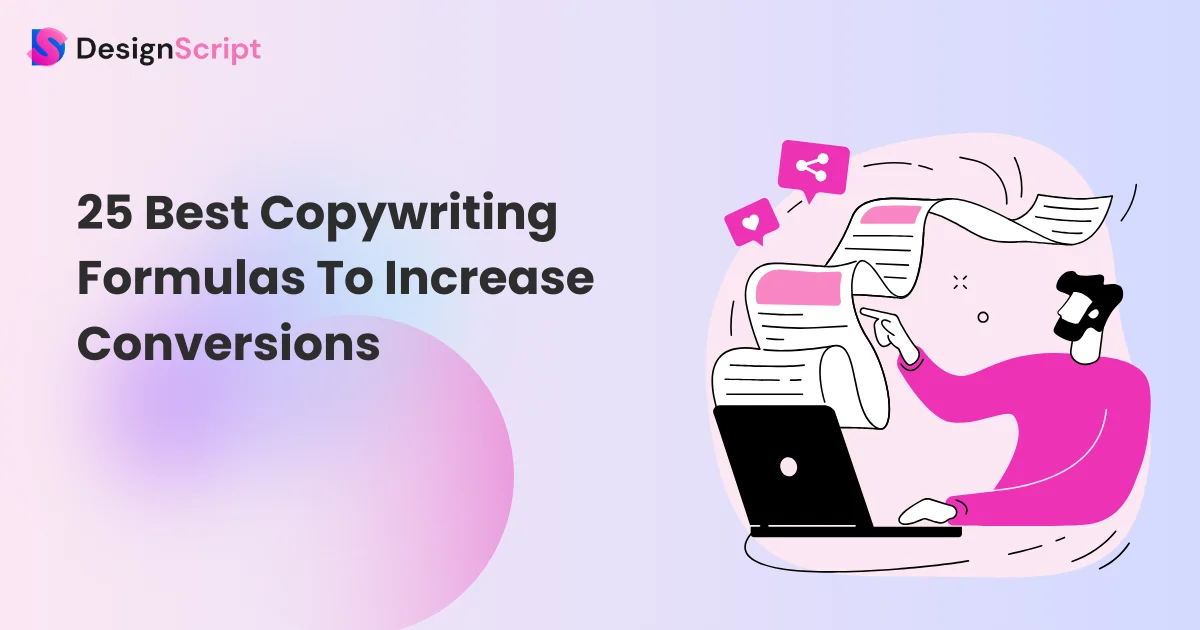25 Best Copywriting Formulas To Increase Conversions
Copywriting is an art that takes most marketers years to master. It is especially hard at a time when engagement levels are at an all-time low. It is not surprising that 79% of readers never read the entire web copy in front of them. Instead, they just skim through it.
So, what should you do to get people to actually read your copy? Apart from your presentation, the words you choose and how you put them together on the page often have the most impact. That is why you have copywriting formulas to streamline the process further.
In order to better grasp the benefits of content marketing, let’s know what copywriting formulas are, why you need them, how to pick the right formula for you and look at a few copywriting examples for better understanding. They are the best copywriting secrets!
Table of Content
What Is A Copywriting Formula?

Copywriting formula is a method for writing a persuasive copy. A copy is written information that promotes a service or product either virtually or offline.
Writers usually write copy to convey different types of information to audiences and urge readers to take some action, such as purchasing or subscribing.
They aim at boosting traffic, engagement, leads, and conversion rate or the percentage of website visitors who become paying customers. The various forms of copy include – a web page, a blog post, an email, a headline, or even an ad.
Writers can utilize a variety of formulas to write a copy that is clear, useful, and appealing to the intended audience and is aligned with their company’s mission and purpose. Instead of inventing a new structure for each assignment, writers can finish their tasks faster by following these useful formulas.
Good formulas are typically easy to remember and work well in persuading potential customers to explore more about a company. They can work well in improving your copywriting skills.

Why Use A Copywriting Formula?
Adopting copywriting formulas means you won’t have to start fresh each time you sit to draft one. You have a clear idea of what to write and how to write it, freeing up your mind for more brainstorming and an influx of creative ideas.

It might serve as a helpful guide for writers attempting to advertise a service or product. Here is a look at the other advantages of using copywriting formulas:
- Get the nudge – If you find it difficult to pen down your thoughts, a copywriting formula can come to your rescue. It can be the starting point for ideas and help you begin writing.
- Create copies faster – Rather than spending time creating an outline for your copy before beginning to write, you can make use of a content marketing strategy to go right into creating actual content. Formulas can inspire you and help increase your productivity.
- Attract readers – With copywriting formulas, you can capture readers’ attention as it is essential to create brand awareness about you and your product. You can craft compelling stories that draw returning visitors to your website using them.
- Make readers perform CTA – A formula helps you persuade customers with your message. Usually, it is about a particular product that solves the customer’s pain points.
- Make copy easy to understand – Formulas can make writing easy to understand, and the message is clear to the target audience. A copy that is useful to readers is more likely to retain customers and attract new ones.
- Ensures consistency – Different copywriters use the same formula to make a company’s copy consistent and easy for customers to relate to. Businesses have a structure that outlines their guidelines of how they want writers to portray their images to the target audience.
What Makes A Good Copywriting Formula?

There are a few characteristics that all the top copywriting formulas have:
- They are easy to learn and remember.
- They can be equally helpful to novice and pro copywriters in crafting an excellent copy, which is also one of the copywriting skills.
- They have successful track records.
How To Select The Right Copywriting Formula?
The best way to choose the right copywriting formula is to
- Set your objectives
- Know your target audience
- Finalize the key message you want to put across
When you are sure about this, you can easily choose the right copywriting formula for yourself.
Here, we have a list of the top proven copywriting formulas you can choose from.
1. AIDA – Attention, Interest, Desire, Action
This well-known copywriting technique may be used in various content types, including YouTube advertising, landing pages, email newsletters, and social media posts. The basic premise of the AIDA copywriting formula is simple: To get people’s attention, be funny or over-the-top. Once you get a reader’s attention, the next step is to convert their curiosity into a want to learn more about your brand, followed by a call to action.
Attention – Catch the reader’s attention with a story, a persuasive or intriguing question or a statement.
Interest – Solve the reader’s problem while also providing new and fascinating information. Use unusual, unexpected or new facts to capture their interest.
Desire – Inspire the reader to really want your product by evoking certain feelings in them. Tell your prospect how and why your offer will benefit them.
Action – A clear call to action that will ideally lead to a conversion. Request them to proceed to the next stage, which is to purchase your product.
2. BAB – Before, After, Bridge
You can write highly-converting copies using the BAB or Before-After-Bridge copywriting formula. The components of this formula are the following:
Before – Show the audience a world with the problem while stressing how it is a cause of worry. Get the audience to relate to the problem and feel as though they are currently facing it.
After – Paint a picture of the world without the problem and evoke feelings of freedom, peace, and hope. Make the audience feel good in that world and draw their attention towards the shift.
Bridge – Present your product or solution as the bridge that leads the audience from the world of problems to the problem-free world.
The psychology behind it is that if you make the audience realize how painful the problem is and how amazing the problem-free world is, they will want to know more about your product or solution that brings in the transformation.
3. PAS – Problem, Agitate, Solve
Another well-known formula in copywriting is PAS. It’s basic but effective, demonstrating that sometimes little is more. Furthermore, It’s a popular choice for different kinds of content, right from tweets to long-form blogs. PAS copywriting formula recognizes the reader’s problem, paints a vivid picture of their pain points, and then suggests a solution. This copywriting strategy will work for you.
Problem – Mention an issue that you know your clients are facing.
Agitate – Use emotions to agitate the issue and make it appear more serious. By detailing the problem in-depth, you can make your target leads want a solution. Make them feel as if there is a pressing issue that requires immediate attention.
Solve – Provide a solution to the issue that the prospect is facing.
Maintain your problem statement concise while using PAS to attract your potential customer’s attention. Then look at why and how your service or product fits in the gaps.
4. FAB – Features, Advantages, Benefits
FAB stands for features, advantages, and benefits. This formula is a combination of emotional appeal and the reader’s imagination. The best part is that you can use it for both long-form and short-form copies. FAB copywriting formula reminds us that the customer is the center of attention, and you have to stress what is in store for them.
Here’s what FAB comprises of,
Features – What your product or service can do
Advantages – What problem does it solve
Benefits – What does that mean for the reader
You can start with the main feature of your product and what makes it better than the competition, and how it helps the customer.
5. The Four C’s – Clear, Concise, Compelling, Credible
This formula works for a wide range of products and services. It’s more like a checklist to see if your copy has all the elements required to persuade the reader. The 4 C’s include the following:
Clear – You must be clear so that everyone in your target audience understands what you want to convey. Don’t use jargon or difficult-to-understand language. Instead, use simple words and bullet points wherever suitable.
Concise – Don’t compose a lengthy essay. Instead, make sure that you keep it short and crisp by using minimal words to get to the point.
Compelling – Use anecdotes to grab your lead’s interest, then focus on their issue and offer a solution.
Credible – Make sure that the target audience finds you credible. Publish your copies on well-known websites and provide customer testimonials to show that your product is trustworthy.
6. ACCA – Awareness, Comprehension, Conviction, Action
While many copywriting formulas appear to focus on how to tell a better story, ACCA is different. It educates the reader before providing a diagnosis that leads to action. The most common users of ACCA are non-profit organizations, but they are not the only ones. ACCA is a version of AIDA that emphasizes clarity and comprehension. You begin with your product’s unique selling proposition, build on it, and then simplify it for the layman. Finally, include your company’s persona. All of these variables will influence how you implement this innovative formula.
Create awareness about the type of problem that your product solves.
Comprehension – This is when you delve in deeper and provide evidence in the form of facts and illustrations. Basically, everything that will help your audience progress from awareness to action. Assist your audience in understanding the reality of the problem.
Conviction – Once the lead can fully understand the situation, there has to be conviction which is a strong desire to do something. You can persuade them to take action on this issue.
Action – Conviction comes naturally if you truly want to increase awareness and encourage the prospects to know the topic well. You can then ask them to take action.
The fact that comprehension is a significant point in this formula sets it apart. While others provide more hypothetical or real-life scenarios, this one is more relevant to the reader’s current situation. When the prospect is going through whatever you’re describing, it can hit them hard enough to make a purchase.
7. The 6+1 Formula – Context, Attention, Desire, Gap, Solution, Call to action, Credibility
Danny Iny devised the 6+1 formula as an alternative to AIDA. It focuses on incorporating context into copywriting. This helps you be creative and make your writing look trustworthy. And with good reason: if you don’t have credibility, your copy and offer won’t actually impress anyone.
The six steps are as follows:
Context – Why are you reaching out to the reader, and what makes you reliable? Simply put, tell your target audience who you are and why you’re speaking to them.
Attention – You must attract the reader to read on, which is the most important component of any formula. Keep your focus on grabbing their attention.
Desire – Create a desire in the prospect to seek the solution. Make the reader want to purchase your product or service. Show why they can’t live without it.
Gap – Focus on the repercussions of both actions and inactions. Explain to the reader what will occur if they don’t take any action.
Solution – Provide a solution to the problem that the target audience is experiencing. Try to present precise information directly to the prospect.
Call to action – The next step you would like the prospect to take is an action, usually purchasing your product by having a clear call to action in the end.
The formula’s +1 element is to maintain credibility throughout the copy.
8. IDCA – Interest, Desire, Conviction, Action
The attention element of AIDCA is removed in IDCA. If someone visits your website or opens your email, you already have their attention. Therefore, you don’t have to do it all over again. In this scenario, it’s best to get straight to the point and explain what you can do for the potential lead. You can use IDCA for that, as it eliminates the need to grab attention. It has the conviction to reassure and persuade readers to take action.
Interest – Create a sense of curiosity in your readers.
Desire – Instill an urge to want what you have to offer.
Conviction – Reassure the readers and persuade them to act.
Action – Make them take the desired action.
9. The 4 P’s – Picture, Promise, Prove, Push
The 4 P’s is another simple copywriting formula. Here’s what each P stands for,
Picture – To get someone into the right frame of mind, you must use words to portray the scenario you want them to be in. You can emphasize this in the problem your solution addresses or the ideal future they wish to become a part of. Paint a picture to pique the reader’s curiosity.
Promise – Once you’ve painted the picture in their minds, you need to show them how you’re going to make it a reality or how you would resolve the issue through the promises that your service or product makes. You can highlight the features and benefits here.
Prove – You can’t just commit without proving it. Support it with statistics, case studies, or a demonstration. You may paint the picture and make promises, but it’s pointless if you can’t back it up. To back your promises, provide customer testimonials and reviews.
Push – After completing these steps, it’s time to motivate the reader to take action. The call to action will drive them over the edge if you focus right on the other three P’s. Encourage your prospect to purchase in the last P.
10. The 4 U’s – Useful, Urgent, Unique, Ultra-specific
This one includes four elements that you should include in your copy. These factors are primarily about what makes your proposal the best option in the first place. It works best as social media copywriting, but it can work elsewhere when done correctly.
Useful – Describe how your product will benefit the prospect.
Urgent – Make it apparent that your product or service is not available for purchase whenever the buyer wants to.
Unique – Use your one-of-a-kind selling point.
Ultra-specific – Explain your proposal in great depth while being specific.
11. AIDCA – Attention, Interest, Desire, Conviction, Action
AIDCA assumes that, in addition to a description of how the product can assist a reader, they also require confirmation that the product or the service is effective and safe. Here, you’re providing the customer with real success statistics.
Attention – A story, a convincing or fascinating inquiry, or a statement can all be used to grab the reader’s attention.
Interest – Provide new and exciting information while solving the reader’s problem. To pique their interest, provide unusual, unexpected, or novel facts.
Desire – Urge the reader to want your product by invoking specific emotions in them. Tell your prospect how and why they will benefit from your offer.
Conviction – Conviction aims to change the minds of prospects who don’t have an interest in purchasing your product or service. Persuade prospects that what you’re saying is real and that it’s safe to take action. Use testimonials, facts, and numbers to accomplish this.
Action – A call to action that, hopefully, will result in a conversion. Insist that they move on to the next step, buying your product.
12. AIDPPC: Attention, Interest, Description, Persuasion, Proof, Close
AIDPPC stands for Attention, Interest, Description, Persuasion, Proof, Close. Invented by Robert Collier, it is the perfect formula for writing copies for websites and emails in addition to creating content for blog posts. You can use it for writing sales and marketing materials as well. If you pay attention, you can see that it resembles the famous AIDA copywriting formula.
Let’s take a closer look at AIDPPC,
Attention – Grab the reader’s attention right at the start.
Interest – Make sure that you give the readers the reason to continue reading.
Description – Provide a description of the problem and a solution for it.
Persuasion – Comments to clear the doubts of potential customers.
Proof – Provide social proof.
Close – Tell the potential customer what to do next.
13. AAPPA: Attention, Advantage, Proof, Persuasion, Action
This copywriting formula stands for Attention, Advantage, Persuade, Action.
It is a complex one that is suitable for long-form content pieces or videos. The aim is to back your claims appropriately and put objections to rest, showing potential customers that they can trust you.
Attention- The first step is to grab the potential customer’s attention. You have to convince the prospect to stay on your page.
Advantage- The next step is to reveal what your product or service can do and list the features and details with the USP of what you are offering.
Prove – It is essential to provide social proof to sound credible.
Persuade- It is essential to be persuasive and make the potential customers want to buy your product or service.
Action – After you are able to persuade them, it is time to tell them to take action.
14. QUEST: Qualify, Understand, Educate, Stimulate/Sell, Transition
This copywriting formula stands for Qualify, Understand, Educate, Stimulate, Transition. It is quite different from the rest. In this formula, the first step involves qualifying the potential customer.
Let’s take a closer look at each step,
Qualify- You have to begin the copy in such a way that the prospect feels that the offer is for only selected individuals. It may filter out a lot of individuals, but that is exactly what you want to do here!
Understand -Try to show them that you understand their situation.
Educate – By now, you will have only those who actually deal with the problem you are talking about. At this stage, you should show them how your product or service can be.
Stimulate – You have to stimulate the buyer to take action.
Transition- Here you transition the prospect to a customer.
While using this formula, there’s a lot of room for improvisation. There is no need to follow it religiously, as you can use your own creativity.
15. PASTOR: Problem, Amplify, Story, Transformation, Offer, Response
This copywriting formula is the brainchild of the famous copywriter Ray Edwards. It stands for Problem, Amplify, Solution, Transformation, Offer, Response.
Here’s a closer look at it,
Problem – Describe the problem the client faces so that they feel that you have the solution. Try using the prospect’s language here without any jargon.
Amplify – The next thing you have to do is tell the reader what would happen if they don’t solve the problem. This would make the reader realize what they will lose if they don’t fix the problem. This has a root in psychology and works well most of the time.
Solution – Tell the reader how you wish to solve the problem. Also, make sure that the proposal is engaging so that you win the heart of the prospects.
Transformation – Demonstrate how your offering can be transformative. Try to provide customer testimonials to show that you are able to do what you promise. Basically, once prospects see that you have already delivered outcomes to their competitors, they are more likely to trust you.
Offer – It is now time to tell what you are offering exactly. Here you provide the proposal while connecting them to the benefits the prospect will get by making the purchase. Nevertheless, be honest here and don’t make false claims.
Response – Don’t hesitate to request the prospect to close the deal here by telling them what to do and why it is essential to do so.
16. FACE: Familiar, Audience, Cost, Education
FACE is a copywriting formula that stands for Familiar, Audience, Cost, Education. This is perfect for writing content pieces when you don’t know their length.
Let’s take a closer look at the four factors of this formula,
Familiar – Is the audience familiar with your blog? Do you need to become more familiar in order to seem trustworthy?
Audience – See who makes up your target audience.
Cost – Mention the cost of your product or service.
Education – Find out if you need to educate your audience before closing the deal.
17. A FOREST
A FOREST copywriting formula stands for Alliteration, Facts, Opinions, Repetition, Examples, Statistics, Threes. While this may seem like a really long formula ideal for blog posts and landing pages, you can shorten it and use it for your post on social media.
This copywriting formula is quite creative and works well most of the time. Let’s break it into smaller chunks:
Alliteration – Use words that begin with the same letter or sound the same.
Facts – Mention facts as they are quite eye-catching.
Opinions – Try to present your perspective based on the facts.
Repetition – Repeat points so that the reader can remember them later.
Examples – Along with facts and opinions, provide examples.
Statistics – Provide stats to back what you claim.
Three – Avoid repeating points three times.
18. The 3 Reasons Why
This is not exactly a copywriting formula but a list of 3 ideas you have to answer in your copy.
Why are you the best? – Answer this question in your copy and what makes you better than your competitors.
Why should the prospect believe in you? – Mention why the prospect should trust you.
Why should the prospect buy right now? – State why the prospect should close the deal immediately.
You can craft a great copy by answering the 3 ‘whys’.
19. Star – Chain – Hook
This hook formula gets the reader’s attention by initially presenting the most interesting part of the copy and focusing on selling it to them later. Copywriters use this formula for shorter copies like captions and brief landing pages, but this doesn’t mean you cannot use it in long-form content pieces. You can use it in the introduction of your article or blog.
The three main parts of this formula include star, chain, and hook.
Star- Your copy should have a star that can draw attention and get the reader interested in reading further. It can be a striking fact or something unique.
Chain – Back up your claims with evidence and facts. This helps increase the desire for your offering.
Hook – The hook here is your CTA. At this point, the reader will be looking for how they can get their hands on what you promised previously. Keep the CTA as clear as you can for the best results.
This copywriting formula works whenever you need to draw the prospect’s attention.
20. The 1 – 2 – 3 – 4 Formula for Persuasive Copy
This copywriting formula involves what the prospect wants to know before purchasing. There are more like puzzle pieces; you need them all to make your copy work.
1. What have I got for you?
You must explain what you are selling in the initial part of your copy. Just start with a description of your product or service and then leave the rest to the steps that follow.
2. What is it going to do for you?
Try to present all the benefits and features of your offering. Bear in mind that if you focus more on the features you are more likely to get an emotional response from the prospect, and they would close the deal faster.
3. Who am I?
While this step is completely optional, you can always add a brief bio about yourself to make it more relatable & help build stronger bonds.
4. What should you do next?
This step is more like directing the reader to take action i.e. The CTA. Make sure that it is clear and the reader does not miss it.
You can use this formula for any type of copy, be it a blog, a page, or anything else.
21. String of Pearls
String Of Pearls is a copywriting formula that involves stringing together a series of stories that persuade. More than a formula, it is a guide for your copy’s structure and layout. Basically, it is about being as persuasive as you can in your copy. The aim is to bring your product or service to the forefront with a series of stories.
Here’s how you can do so
- Create Listicles
- String testimonials together
- String benefits together
22. The Fan Dancer
You may have understood the meaning of this formula from its name. It involves beating around the bush without telling what exactly you are trying to say (in a creative way!). You can use this in social media as email pop-ups and product descriptions. It is a refreshing change from the traditional approach of writing copy which is most often overused. The fresh perspective helps grab the reader’s attention. However, this approach is not suitable for long-form content pieces.
For eg: You can have an email pop up that says, “Hey! Is your email princess@fromapalace? No? We have something for you.“
23. The Approach Formula
This copywriting formula is more in-depth and explanatory, which is why it is not used as much as other formulas. It helps persuade prospects who are hesitant to try your product or service.
Approach stands for Arrived, Propose, Persuade, Reassure, Orchestrate and Ask.
Let’s break it down,
Arrive – Here, you set the stage for the conversation.
Propose – Introduce your solution to make the prospect know what you offer.
Persuade – In this step, you have to convince the prospect that what is the best possible choice they can make.
Reassure – Provide social proof to build credibility.
Orchestrate – Like a musical orchestra, try to bring everything together.
Ask – This is the CTA that helps the reader to take the next step, which is most often to make a purchase.
This formula is the best bet when it is a high-value one.
24. UPWORDS Formula
This copywriting formula created by Michael Fortin adds images to your writing. It stands for Universal Picture Words For Relatable Descriptive Sentences.
Using this copywriting formula will make the copy more sarcastic and funny. You can use it for social media as well as for captions to create engagement. It creates imagery that attracts the reader to you and builds a connection making it one of the best copywriting tips around.
Here’s an example,
Hiring the wrong person to design your brand’s logo is like going to prom with a face full of acne.
25. Star-Story-Solution
This copywriting formula is used widely as it is short and focuses on a character. It is the best bet for writing copies for lead generation, such as a sales letter. It is worth noting that this particular formula doesn’t rely on data and facts to make customers purchase the product; there is the use of emotions instead.
Here’s how it goes.
- Introduce the story’s star.
- Narrate the story of the star.
- Talk about the solution that helped the star win.
With this, we come to the end of our list of the top easy formulas for copywriting.
Start Using Copywriting Formulas To Craft Compelling Copies!

As you just saw, there are several different formulas to help you with copywriting. Some of these are similar, but the main purpose is to persuade the readers to take the desired action. On the whole, copywriting requires you to read your readers’ minds and know how to get them to accept your offers. With pre-set easy formulas, the task of creating stellar content becomes less challenging.
You can thank us later for simplifying your job!
FAQs
AIDA is an easy formula for copywriting that stands for Attention- Interest-Desire-Action. It involves capturing the reader’s attention, arousing their curiosity about your offering & providing a call to action.
PAS is a copywriting formula that stands for Problem-Agitate-Solve. Here, you identify the reader’s problem, paint a picture of the reader’s pain points, and provide a solution.
The purpose of copywriting is different from that of content writing. You try to persuade the reader to take action with the former, while the latter involves education or entertaining the reader.

